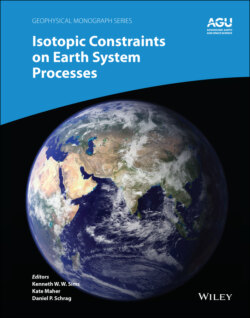Читать книгу Isotopic Constraints on Earth System Processes - Группа авторов - Страница 34
1.5.2. Natural Examples of Lithium Zoning and Isotopic Fractionation by Diffusion in Pyroxenes
ОглавлениеSeveral well‐documented instances of large lithium isotopic fractionations in natural pyroxenes from terrestrial rocks (Jeffcoate et al., 2007; Parkinson et al., 2007) and from Martian meteorites (Beck et al., 2006) had been reported prior to the lithium diffusion experiments described. This section gives two examples that use the parameters derived from the experiments to interpret the significance of the isotopic fractionation, or the lack thereof, of zoned pyroxene grains from terrestrial rocks and from a Martian rock.
Figure 1.13 Lithium concentration data normalized by the average value in the interior (left‐hand panels) and isotopic fractionation data relative to the average in the interior that defines δ7Li = 0.0‰ (right hand panels with ±2σ of clinopyroxene grain CPX 95.11.14.10 from a Solomon Island lava flow measured by Parkinson et al. (2007). The black lines are from model calculations that assumed that the lithium concentration and isotopic composition was initially uniform. The isotopic profile was calculated using δ7Li = 0.0‰ as the boundary condition and with the relative mobility of 7Li compared to 6Li specified using βLi = 0.25. Richter et al., 2014b.
Fig. 1.13 shows the lithium concentration and isotopic fractionation measured by Parkinson et al. (2007) across a clinopyroxene grain from a lava flow in the Solomon Islands. The data are very much like those from the experiment shown in Fig. 1.12 and the model profiles that fit the isotopic fractionation data were calculated using a value of β Li = 0.25, which is effectively the same as that determined by the Richter et al. (2014b) experiments ( β Li = 0.27). A number of other examples of lithium‐zoned pyroxene grains with associated isotopic fractionations that quantitatively conform to the expectation derived from the laboratory experiments can be found in recent papers by Richter et al. (2014b; 2016). It’s pretty clear that the lithium zoning of these grains is the result of the diffusion of lithium.
Isotopic measurements across zoned mineral grains are important regardless of whether significant isotopic fractionations are found. A good illustration of this is a lithium‐zoned pyroxene grain from the Martian meteorite Shergotty, where the important point is precisely that there is little if any significant isotopic fractionation despite it being strongly zoned in lithium abundance. Fig. 1.14 shows the lithium concentration and isotopic fractionation data that was measured on a transect across the pyroxene grain from Shergotty with the CAMECA 1270 ion microprobe at the Centre de Recherches Pétrographiques et Géochimiques in Nancy, France. The lithium concentration data can be reasonably fit by a calculation that assumes that the zoning was due to lithium having diffused out of an initially homogeneous grain. However, the associated lithium isotopic fractionation calculated using the relative diffusivity of 6Li and 7Li from the laboratory experiments (i.e., β Li = 0.27) resulted in a profile with a shape and amplitude that is nothing like the measured data. The lack of significant isotopic fractionation across this grain suggests that the zoning was most likely the result of crystallization from a melt of evolving composition. Had it not been for the isotopic data, one might have incorrectly assumed that the lithium zoning was due to diffusion and used it to make a spurious calculation of the cooling rate of the host rock. In fact, the cooling rate of the host rock must have been extraordinarily fast (> 100°C/hr) as there was not enough time for any significant diffusion of lithium down the concentration gradient.
Figure 1.14 Results of a diffusion calculation for the evolution of the lithium abundance and isotopic fractionation of a grain with an initial 6 ppm lithium concentration (dashed line) and 1 ppm at each edge. The panel on the left shows the calculated lithium concentration profile that developed after a time such that it resulted in a reasonably good fit to the measured lithium concentration data shown as unfilled circles. The panel on the right compares the measured lithium isotopic fractionation across the grain (black circles with two sigma error bars) with the lithium isotopic fractionation calculated assuming δ7Li = 0‰ as the initial and boundary condition and with the relative diffusion coefficients of the lithium isotopes calculated using βLi = 0.27.
